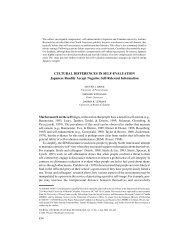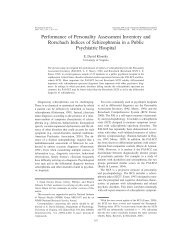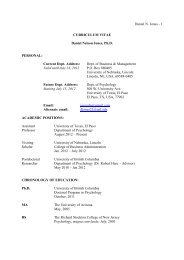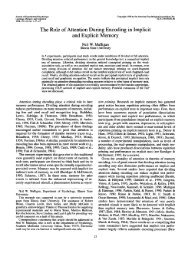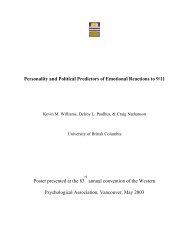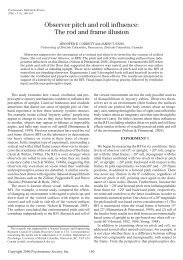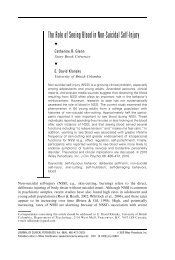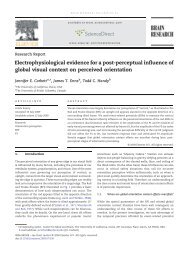Dynamic Social Impact and the Evolution of Social Representations ...
Dynamic Social Impact and the Evolution of Social Representations ...
Dynamic Social Impact and the Evolution of Social Representations ...
Create successful ePaper yourself
Turn your PDF publications into a flip-book with our unique Google optimized e-Paper software.
Journal <strong>of</strong> Communication, Autumn 19%<br />
Heider. F. (1958). Thepsychology <strong>of</strong> intetpersonal relations. New York: Wiley.<br />
Hillier, B., & Hanson, J. (1984). lbesocinl krgic <strong>of</strong>.space. Cambridge, Engl<strong>and</strong>: Cambridge University Press.<br />
Huguet, P., LatanC, B., 62 Bourgeois, M. (1995, July). A social representation emerges from communication.<br />
Poster presented at <strong>the</strong> annual meetings <strong>of</strong> <strong>the</strong> American Psychological Society, New York.<br />
Hull, D. L. (1988). Science as aprocess. Chicago: University <strong>of</strong> Chicago Press.<br />
Jahoda, G. (1988). Critical notes <strong>and</strong> reflections on social representations. EuropanJournal <strong>of</strong><br />
<strong>Social</strong> Psychology, 18, 195-209.<br />
Jaspars, J,, & Fraser, C. (1984). Attitudes <strong>and</strong> social representations. In R. Fan & S. Moscovici (Eds.),<br />
<strong>Social</strong> representations (pp. 101-123). Cambridge, Engl<strong>and</strong>: Cambridge University Press.<br />
J<strong>of</strong>fe, H. (1994, October). <strong>Social</strong> representations. Paper presented at <strong>the</strong> annual meetings <strong>of</strong> <strong>the</strong><br />
<strong>Social</strong> Psychology Section <strong>of</strong> <strong>the</strong> British Psychological Society, Cambridge. Engl<strong>and</strong>.<br />
Judd, C. M., & Krosnick, J. A. (1989). The structural bases <strong>of</strong> consistency among political attitudes:<br />
Effects <strong>of</strong> political expertise <strong>and</strong> attitude importance. In A. R. Pratkanis, S. J. Breckler, & A. G.<br />
Greenwald (Eds.), Attitude structure <strong>and</strong>function (pp. 99-128). Hillsdale, NJ: Erlbaum.<br />
Katz. D., & Braly, K. (1933). Racial stereotypes <strong>of</strong> one hundred college students.Journaloj'<br />
Abnormal <strong>and</strong> <strong>Social</strong> Ps-ychologl: 28, 280-290.<br />
Kleinpenning, G., & Hegendoorn, L. (1993). Forms <strong>of</strong> racism <strong>and</strong> <strong>the</strong> cumulative dimension <strong>of</strong><br />
ethnic attitudes. <strong>Social</strong> Psychology Quarterly, 56, 21-56.<br />
Krause, E. F. (1975). Taxicab geomety: An adventure in non-Euclidian geometry. Menlo Park, CA:<br />
Addison-Wesley.<br />
Langton, C. G. (1989). Artificial life. Redwood City, CA: Addison-Wesley.<br />
Latane, B. (1981). The psychology <strong>of</strong> social impact. American Psychologist, 36, 343-356<br />
Latane, B. (1996a). <strong>Dynamic</strong> social impact: The societal consequences <strong>of</strong> human interaction. In C.<br />
McGarty & A. Haslam (Eds.), The message <strong>of</strong> socialpsychologv: Penpctit~es on mind <strong>and</strong> society.<br />
Oxford, Engl<strong>and</strong>: Blackwell Scientific Publications.<br />
Latane, B. (199613). <strong>Dynamic</strong> social impact: Robust predictions from simple <strong>the</strong>ory. In R<br />
Hegselmann, U. Mueller, & K. G. Troitzsch (Eds.), Modelling <strong>and</strong> simulation in <strong>the</strong> social sciences<br />
from <strong>the</strong>philosoph.y <strong>of</strong>sciencepoint <strong>of</strong> vieu! (pp. 287-310). Dordrecht, The Ne<strong>the</strong>rl<strong>and</strong>s: Kluwer<br />
Theory & Decision Library.<br />
Latane, B. (1996~). The emergence <strong>of</strong> clustering <strong>and</strong> correlation from social interaction. In R.<br />
Hegselmann 62 H. 0. Peitgen (Eds.), Modelle sozialer dynamiken: Ordnung, chaos rind<br />
komplexitlit (pp, 79-104). Vienna, Austria: Holder-Pichler-Tempsky.<br />
Latant!, B. (1996d). Strength from weakness: The fate <strong>of</strong> opinion minorities in spatially distributed<br />
groups. In E. Witte 62 J. H. Davis (Eds.), Underst<strong>and</strong>ing group behavior Corxensual action by<br />
smalf groups (pp. 193-220). Hillsdale, NI: Erlbaum.<br />
Latane, B., & Harkins, S. (1976). Cross-modality matches suggest anticipated stage fright a multiplicative<br />
power function <strong>of</strong> audience size <strong>and</strong> status. Perception <strong>and</strong> Psychoph-ysics, 20, 482-488.<br />
LatanC, B., & L'Henou, T. (1996). Spatial clustering in <strong>the</strong> Conformity Game: <strong>Dynamic</strong> social impact<br />
in electronic groups. Journal <strong>of</strong>Personality <strong>and</strong> <strong>Social</strong> Psychology, 70, 1218-1230.<br />
Latant!, B., Liu, J,, Nowak, A,, Bonevento, M., & Zheng, L. (1995). Distance matters: Physical space<br />
<strong>and</strong> social impact. Personality <strong>and</strong> <strong>Social</strong> Psychology Bulletin, 21, 795405.<br />
Latane, B., & Nowak, A. (1994). Attitudes as catastrophes: From dimensions to categories with<br />
increasing involvement. In R. Vallacher & A. Nowak (Eds.), @numica1 system in sociafpsychology<br />
(pp. 6344). New York: Academic Press.<br />
74



